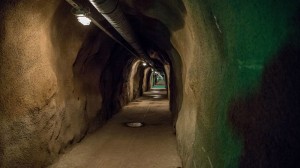The Author:
Hayley Kilmurry is the Sales and Marketing Co-ordinator at the Genus UK Head Office
How is Germany protecting its cultural heritage from war and natural disasters? – Microfilm, of course !!!!!
German Archives Underground Vault 1
With the increase in digital storage media and formats and the need for archives to be accessible, lots of organisations had begun to see microfilm as an old-fashioned medium for storing documents but as time moves on we are seeing ever more organisations reverting back to storing important data on microfilm.
Claus Peter-Iff, Export Manager at the Genus Offices in Germany, recently informed us of a report on ZDF news on how The German Archives are storing their precious documents in a unique way, but on a not so unique format – good old microfilm.
100m below the “Schauinsland” mountain in the Black Forest near Freiburg you will find Barbarastollen, also called Oberried tunnel or Oberrieder tunnels.
This once disused supply tunnel is now an underground archive to preserve Germany’s cultural heritage.
The Barbarastollen tunnel is the only cultural property in Germany under the protection of the Hague Convention of UNESCO. It is named after Saint Barbara.
The rolls of microfilm have been stored securely since 1975, in 1,500 containers made of stainless steel, and hold about 900 million images from German Archives and Museums.
Among the documents stored are
1. The Treaty text of the Peace of Westphalia,
2. The Coronation document of Otto I,
3. Documents of Johann Wolfgang von Goethe,
4. The original building plans for the Cologne Cathedral and most recently,
5. the original version of the German Constitutional Law.
The documents are held on Microfilm at the German National Archives where they have been captured and reduced twelvefold.
All the files have been provided by the Federal Archive in Berlin to the German Bundestag ( The National Parliament of the Federal Republic of Germany ).
A total of 2.6m files have been processed and are now securely stored for the next 500 years and this only amounts to about 5% of the German archives.
German Archives Underground Vault 2
The entire complex is buried under 400 meters of rock and is intended to survive a nuclear war.
It is estimated that its contents should survive for at least 500 years without any serious damage, neither war, natural disaster nor water, dust or fluctuation in temperature can harm or damage the cultural assets.
As more and more of our information is stored digitally on hard drives and the cloud, it is easy to suggest that microfilm has become an obsolete medium but these digital files are still at risk of malicious hackers, human error, and media formats becoming obsolete.
Mini-discs, VHS, and the humble floppy disks have become outdated “but a slide back into the technological dark ages is not beyond comprehension.”
In a recent article I read on The Memory of Mankind project “The Worlds Knowledge is being buried in a salt mine” The project aims to save our most precious documents from an “apocalypse”.
Their plan is to gather together the accumulated knowledge of our time on microscopic engravings – “ceramic microfilm” and store it underground in caverns carved out in one of the oldest salt mines in the world, in the mountains of Austria’s picturesque Salzkammergut.
In this article Martin Kunze, an Austrian ceramist, and researcher who invented them, made a good point, “At a conference of space weather scientists, together with officials from NASA and the US Government”, earlier this year warned of the fragile nature of all this digital information.
Charged particles thrown out by the sun in a powerful solar storm could trigger electromagnetic surges that could render our electronic devices useless and wipe data stored in memory drives. ” The point being that these methods are not always fail-safe”.
Microfilm in whatever form is human readable, even with no power the microfilm can still be viewed using a simple light source such as a candle and a magnifying glass and if stored in the right conditions such as the Babarastollen bunker can last up to 500 years.
As stated by the Managing Director of Genus – Paul Negus “More and more organisations are going back to the future and using digital microfilm.
What many thought of as an obsolete medium is now being reinvented.
No longer do you have to worry about chemicals and a manual photographic process.
Now digital files can be written directly to a microfilm drive for automatic conversion of digital files into an analogue version on machine readable microfilm.
Microfilm has an official Life Expectancy rating of 500 years, using ISO 10602:19952 and ISO 18901:20103”
So is Microfilm becoming a new and exciting trend in digital preservation?
Will other organisations follow in the footsteps of the German National Archives and decide to convert to microfilm to ensure their digital files have a backup? It certainly makes sense in order to preserve our heritage.



